

see also: I. Pracka, W. Giersz, M. Świrkowicz, A. Pajączkowska, S. M. Kaczmarek, Z. Mierczyk, K. Kopczyński, "The Czochralski growth of SrLaGa3O7 single crystals and their optical and lasing properties", Materials Science and Engineering, B26, 1994, pp. 201-206
and: I. Pracka, W. Giersz, M. Świrkowicz, A. Pajączkowska, S. M. Kaczmarek, Z. Mierczyk, K. Kopczyński, „The Czochralski growth of SrLaGa3O7 single crystals and their optical and lasing properties”, „Selected Papers on Laser Crystal Growth”, Robert Uhrin, editor, vol. MS 164, pp. 322-327, published by SPIE-The International Society for Optical Engineering, Bellingham, WA, USA, 2000
of
SrLaGa3O7:Nd3+ crystal
S.M. KACZMAREK, Z. MIERCZYK, K. KOPCZYŃSKI
00-908
Warszawa, Poland
1. Introduction
The
Srlaga3O7:Nd3+ crystal (SLG) belongs to the
family of gallate and lantanate of rare earth elements, which are described by
general formula ABC3O7. The A symbol in the formula means
Ca, Sr or Ba, the B symbol means La or Gd and the C means Al or Ga. As an
example of the member of this family of compounds the
BaLaGa3O7:Nd3+ crystal was described in Refs.
[2, 3, 4]. However, the high energetic threshold for pumping that crystal was
observed (about 90 J, [3]). It is due to the high density of defects in the
crystal structure and eliminates it from the group of new active materials
useful in laser technique.
Substituting barium by strontium
in the compound and obtaining the
SrLaGa3O7:Nd3+ crystal should improve the laser
characteristics because these elements have small difference of ion radii (it is
equal to 6%). This is confirmed by the results of this work: the generation
threshold of about 9 J was observed in laser resonator with output mirror of 37%
transmission. For comparison, in the same resonator the threshold equal to 3 J
was observed for YAG:Nd3+ laser rod.
Parameters
of the SrLaGa3O7:Nd3+ crystals
DensityLuminescence decay timeEffective
bandwidth for the transition 4F3/2
– 4I11/2 2 at 300 K Cross-section
for stimulated emission by light polarized: perpendicularly
to the optical axis parallel
to the optical axis Wavelength
of generated radiation Refractive
index Nd3+
concentration (10% by weight) |
5.23
g/cm3 290
ms 16.9
nm
5.96
10-24 m2 2.98
10-24 m2 1060
nm 1.84 5.53
1026 m-3 |
The paper presents the
investigation of spectral and generation characteristics of
SrLaGa3O7:Nd3+ crystals manufactured by
Institute of Electronic Materials Technology, Warsaw. The crystals were produced
using Czochralski’s method. The main parameters of the manufactured crystals are
given in the Table.
2. Experimental
results
2.1
Spectroscopic measurements
Four laser rods of 4 mm in diameter and one plano-parallel plate with thickness 6.7 mm was manufactured using the SrLaGa3O7:Nd3+ crystal with 10% by weight of Nd3+ doping. The rods used in this papers were designed SLG1, SLG2, SLG3 and SLG4 and they have length 48.5, 48.8, 35.0 and 36.8 mm, respectively. The spectrometers used to measure the characteristics were UVVIS LAMBDA 2 and FT-IR 1705 from Perkin-Elmer.
Fig. 1. Spectrum of absorption coefficient for SrLaGa3O7:Nd3+ plate Fig. 2. Spectrum of absorption coefficient for SrLaGa3O7:Nd
in the wavelength range of 200-7200
nm
plate in
The absorption spectrum within
the range 200-6200 nm is shown in Fig. 1. It is visible the absorption edge at
250 nm and also the lattice absorption for the wavelengths greater than 6200 nm.
More detailed absorption spectrum (within the wavelength range 300-1100 nm) is
given in Fig. 2.

Fig. 3. Changes of absorption for excited SLG rod: 1 – before
excitation, 2 – 1 hour after excitation without any UV removing filter, 3 – 1
hour after excitation with GG-5 filter, 4 – 24 hours after excitation, 5 – 72
hours after excitation
The spectral measurements were
repeated after the investigation of laser generation to determine the influence
of the flashlamps radiation on the absorption characteristics of the crystal.
The essential changes in absorption spectrum were observed within ranges 346-368
nm, 429-441 nm and 450-490 nm. To determine if these changes are durable, the
next series of the measurements were curried out. The results are shown in Figs.
3-5. The changes of the absorption of the investigated rods and plate are given
there as a function of time measured from the moment of their excitation by 40
pulses from the pumping flashlamp, each of energy 24 J. Within 24 hours the
characteristics does not return to the form observed before the excitation,
hence the changes are stable.
To determine the reasons why the
above described changes take place, the investigated rod and plate are then
annealed in oxidizing atmosphere. The spectral characteristics of absorption
confirms the disappearing of these newly-created absorption bands. However,
these bands appear again when the annealed crystals have been excited by
flashlamp radiation (see Fig. 6). The probable reason of such changes in
absorption spectra is a presence of doping centers [5] in the crystal lattice.
Hence, the further works on quality improvements of the manufactured crystals
are necessary.
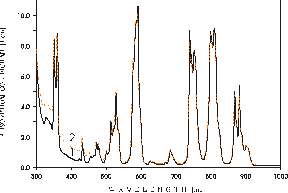
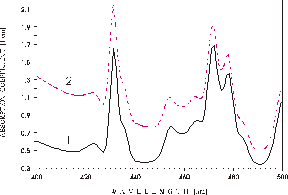
Fig. 4. Changes of absorption for the excited SLG plate: 1 – before Fig. 5. Details of changes of absorption for the excited SLG plate:
excitation, 2 – after
excitation by 40 flashes of energy 25
J 1 –
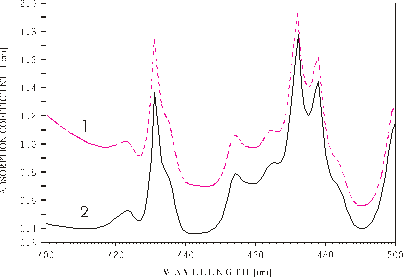
Fig.
6. Changes of absorption for the annealed and excited SLG rod: 1 – 1 hour after
excitation, 2 – after excitation and annealing
2.2.
Free-running laser emission
The
investigations were curried out using laser resonator of length 24 cm, with
plane mirrors. The output mirror of different transmission was applied (i.e. 8,
20, 37, 42, 51, 62 and 75%).
The
laser head consisted of a single linear flashlamp of 4 mm in diameter and a
reflector made of gold-covered brass. The duration of flashlamp pulse was equal
to 120 ms and the power supply can supply energies within range from 7 to 100 J.
To avoid the parasite heating of the laser rod the cut-off filters made of GG-5
glass (cut-off wavelength 350 nm) were used. The emitted laser radiation energy
was measured by means of Gentec Model ED-200 probe. Simultaneously, the laser
pulses were observed on the Tektronix oscilloscope using a high-sensitivity Si
photodetector.
The results of the investigations of the four rods are shown in Figs. 7-10. The differential efficiency of the SLG1 laser rod, compared to the efficiency of YAG:Nd3+ rod is shown in Fig. 7. It is clearly visible the higher efficiency of the YAG:Nd3+ rod. The influence of the excitation of doping centers on the generation characteristics of the SLG crystal is shown in Fig. 7 as the curve 2. The stable change in the spectral characteristics caused decrease of the laser efficiency and increase of the threshold pump energy. It is observed also that placing the GG-5 glass plate within the resonator (to cut-off the UV radiation) caused decrease of emitted energy and increase of generation threshold.
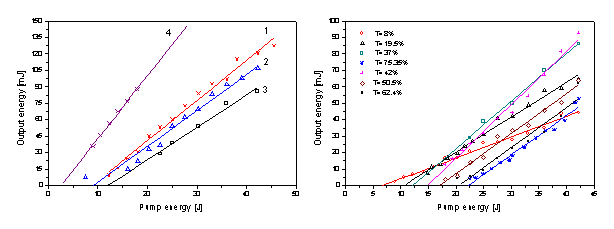
Fig. 7. Efficiency of the SLG (with SLG1 rod) and YAG lasers: 1 – SLG, first measurement (efficiency 0.37%, threshold 8.842 J), 2 – SLG, second measurement (efficiency 0.33%, threshold 9.075 J), 3 – SLG with GG-5 filter (efficiency 0.29%, threshold 11.995 J), 4 – YAG (efficiency 0.57%, threshold 2.848 J)
Fig. 8. Output energy of the free-running laser with SLG1 rod and different output mirrors
The
dependence of the generation thresholds and laser efficiency on the transmission
of the output mirrors is shown in Fig. 8 and 9. The characteristics given there
also define the value of dynamic loss coefficient. It is visible in Fig. 9 that
this value is small (r=0,0523
cm-1) if we consider the presence of defects in the crystal, but it
is large comparing to the value of dynamic loss coefficient for
YAG:Nd3+ rods (r=0.005
cm-1).

Fig.
9. Determination of dynamic loss coefficient (value of the dynamic loss
coefficient is equal to 0.065 cm-1. Kr – resonator loss
coefficient)
Fig. 10. Efficiency of the SLG1 and YAG lasers vs.
transmission value of the output mirror
The dependence of the SLG laser
efficiency on the transmission of output mirror is shown in Fig. 10. It is
compared with the efficiency of the YAG:Nd3+ laser shown in the same
figure. The optimized value of the output mirror transmission is equal to 37.7%
for the SLG1 rod.
2.3.
Single pulse generation
The investigation of single pulse generation was curried out for optimized value of the output mirror transmission. The passive Q-switch was used (dye foil of type PMM:[BDN], transmission To=46.6%). The UV region was removed from the spectrum of pumping light by means of plates made of GG-5 glass (cut-off wavelength 450 nm) and sodium glass (cut-off wavelength 350 nm), which were placed into the laser resonator.
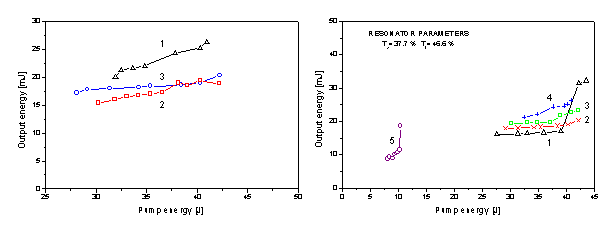
Fig. 11. Generation of the single pulse by the SLG1 rod (output mirror transmission equal to 37.7%): 1 – with GG-5 filter, 2 – with AR coatings, 3 – without filter
Fig. 12. Comparison of the single pulse generation for SLG and YAG rods: 1 – first measurement, 2, 3 – measurements with GG-5 filter, 5 – YAG rod
The generation of a single pulse obtained for SLG1 laser rod is shown in Fig. 11. The generation was investigated without and with UV-removing plates in the resonator. As it can be observed, the deeper UV cut-off (GG-5 glass plate) improves essentially the generation characteristics of the laser, i.e. the laser pulse energies are higher and generation threshold is lower. Using the plate made of sodium glass has practically no influence on the laser generation.
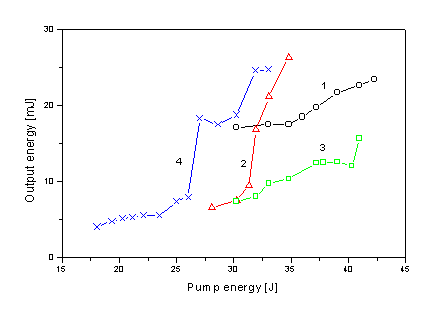
Fig. 13. Generation of the single pulse for all manufactured SLG rods
(with GG-5) filter): 1 – SLG1 rod with AR coating, 2 – SLG2 rod without coating,
3 – SLG3 rod without coating, 4 – SLG4 rod without coating
The increase of the energy of output
laser pulse observed if the GG-5 glass plate is present in the resonator is a
contrary effect, comparing to the appropriate changes of energy during
free-running generation (see Fig. 7).
The comparison of a single laser
pulse generation for SLG and YAG rods is shown in Fig. 12. All investigated rods
cut out from the same SrLaGa3O7:Nd3+ crystal
have different threshold energies for pulse generation, as can be seen in Fig.
13.
3.
Conclusions
It
was stated, that the investigated SLG crystals are suitable for pulsed laser
applications, despite of their structural imperfection which increases threshold
energy values comparing to YAG crystals. The energy of obtained single pulses
was two times higher than for the YAG rod in the same resonator.
It is necessary to remove the
parasite UV radiation (of wavelengths shorter than 450 nm), because of rod
heating and exciting of doping centers.
The threshold of laser generation
and the efficiency can be improved if the crystal has less defects
concentration. The doping with Nd3+ ions is essential here, because
the Nd3+ ion is smaller than La3+, substituted by the
former in the lattice.
References
1. W.
Ryba-Romanowski
et al.: Mater. Sci. Eng. B., (1992) (in the print)
2. 2.
W.
Ryba-Romanowski
et al.:J. Lumin., 36 (1987) p.369
3. 3.
W.
Ryba-Romanowski
et al.: J. Phys. Chem. Solids, 49 (1988) p. 199
4. 4.
M.
Berkowski
et al.: Electronic Properties of High Tc Superconductors, June
1990
5. 5.
A.F.
Ludtschenko:
Quantum transitions in doping centers of solids, Naukova Dumka, Kiev 1978